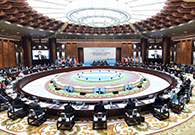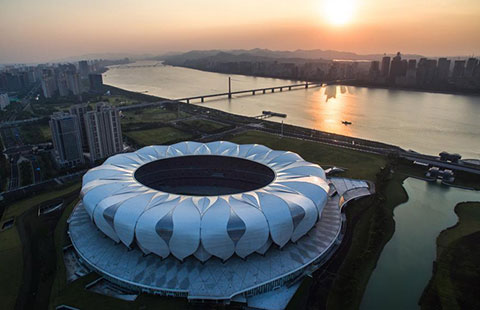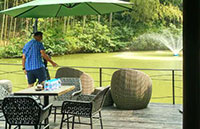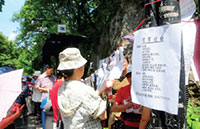Cold front to push away smog in central and east China
By Jin Haixing (China Daily) Updated: 2013-01-16 00:38The heavy smog that shrouded central and eastern parts of China in recent days is expected to disappear gradually starting on Wednesday as a cold front moves in, and experts gave suggestions on how to deal with similar weather.
The combination of pollution and fog will disappear as the strong cold front sweeps through most of China from north to south, but in some areas the fog will remain, Ma Xuekuan, chief forecaster of the National Meteorological Center, said on Tuesday.
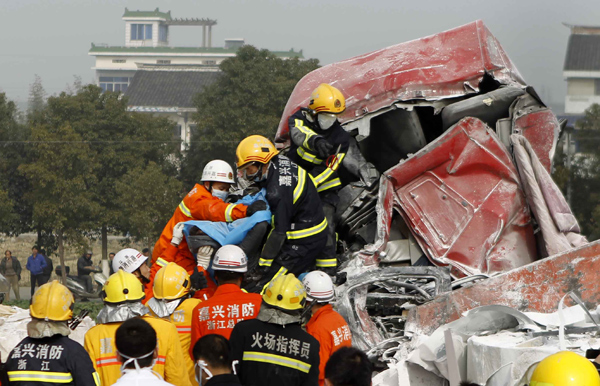 |
|
Firefighters remove a victim's body from a crashed truck after a 20-vehicle pileup at around 8:30 am on Tuesday on the Hangzhou-Pudong Expressway in Zhejiang province. Firefighters suspect that heavy fog was a major factor in the accident that killed two people and injured eight. [Zhao Yingshuo/For China Daily] |
Beijing and other cities in central and eastern China have been shrouded in smog since Jan 7, and air quality in those areas reached hazardous levels.
Ma attributed the lingering smog to higher temperatures and a stable atmosphere, which were not able to disperse the air pollutants.
Cities such as Beijing are not expected to see severe smog next week, Ma said.
Focus on PM2.5
Experts advised the public to pay attention to the levels of PM2.5 ― air particles smaller than 2.5 microns that are able to enter the lungs ― the density of which reached over 900 micrograms per cubic meter in some areas of Beijing on Saturday evening.
Exposure to PM2.5 can be harmful to people's health, especially for those with heart or respiratory diseases, said Li Qiang, a researcher at the Chinese Center for Disease Control and Prevention.
When the PM2.5 density is over 150 mcg per cu m, elderly people and children should avoid strenuous exercise outdoors, Li said.
Under severe conditions, wearing N95 filter respirators ― a type of mask ― is a good way to deal with high PM2.5 levels, Li said.
“Opening windows for ventilation is a good habit in normal conditions, but when the PM2.5 density is very high, people should not open their windows,” Li told reporters at a conference held by the China Association of Science and Technology.
Protection tips
In addition to the masks, small green plants and air purifiers have also become popular in online shops and supermarkets in recent days.
Zhang Jinliang, a researcher at the Chinese Research Academy of Environmental Sciences, said on Tuesday that according to her research, some green plants reduce air pollutants, but the effects are limited.
As for the air purifiers, Zhang said that a national standard for the industry is needed.
People should also clean their air purifiers regularly and replace the filters, otherwise the purifiers become sources of air pollution, Zhang said.
More important, people should not only rely on those products, but should visit the hospital if they don't feel well, Li from the CDC said.
Slow release of info
China's research on PM2.5 second to none, but in terms of air quality standards and the release of information, China needs to improve, said Wang Gengchen, a researcher at the Institute of Atmospheric Physics of the Chinese Academy of Sciences.
Since Jan 1, real-time data on PM2.5 levels in China's 74 major cities has been available to residents, a move undertaken at the request of the public, according to a Xinhua News Agency report.
Gu Song, a reporter from Xinhua, said that he received a message from the government warning about the smog and air quality on Tuesday, which he thought was too late.
However, Zhang from the Chinese Research Academy of Environmental Sciences, said that a warning system for smog is complicated to set up because it needs the cooperation of several departments, such as the transport, environmental protection and meteorological departments.
Residents of Beijing and other cities should reduce their use of cars, which is not an easy task, Zhang said.
- China concerned over downgrade of panda's conservation status
- First lady highlights China's fight against AIDS
- Beijing takes firm stance opposing HK agitators
- Nobel laureate Tu Youyou's team makes new progress on artemisinin research
- Giant panda no longer endangered - WWF
- Action, not words needed to lift economy
- CCDI shows progress in hunt for corrupt officials
- Old tale inspires modern marriage market
- Xi urges efforts of BRICS to improve global governance
- Premier Li offers condolences over death of Uzbek President Karimov


